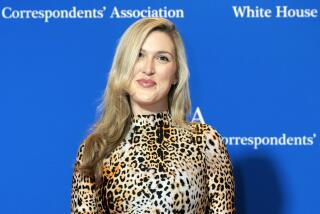Bill Clinton and John McCain share a problem
If Vanity Fair’s current takedown of former President Clinton is any measure, a new standard of campaign journalism has taken root: We will now learn not just about politicians who have affairs. We will learn about politicians whose associates are afraid they might be having affairs.
That’s the foundation of a good part of a lengthy Bill Clinton profile featured in the July issue of the glossy celebrity-centric magazine, which is due to hit newsstands today.
The article, “Comeback Id,” explores many paths Clinton has taken since he left the White House, but a principal one would have us believe that the Big Cat is still catting about. Or at least believe that some smaller -- and thoroughly anonymous -- cats think he might be still catting about.
Clinton lashed out Monday at the story’s author, calling Todd Purdum “slimy,” “sleazy” and “dishonest.” His fury may have been charged, in part, by the knowledge that the writer is married to his onetime presidential press secretary, Dee Dee Myers. (A spokesman later said Clinton regretted his intemperate words.)
It may be of small solace now -- as his wife’s chances at the White House and his time in the campaign spotlight fade away -- but Clinton at least has company this election year. He is the second politician tainted by what might be called “apparent adultery syndrome.”
In February, the New York Times revealed in a quadruple-byline investigation that top advisors to Sen. John McCain “intervened to protect the candidate from himself” when they became convinced during his 2000 campaign that McCain had become romantically entangled with a Washington lobbyist, a charge that both vehemently denied.
Both the Vanity Fair profile and the earlier New York Times story offer not a smidgen of direct evidence (i.e., video, frothy e-mails, lipstick-smeared collars, anything) to prove that either politician cheated on his wife.
But the new Clinton piece, in particular, offered plenty of innuendo. Vanity Fair relies on “Hollywood dinner-party gossip” and equally obscure sourcing to hint at possible liaisons between Clinton and an actress, “a female friend” and “a woman in a bar.”
More threatening to the former commander in chief’s legacy, Purdum asserts, is his tendency to run with a “fast crowd,” including a pair of tabloid-land Lotharios, Los Angeles supermarket magnate Ron Burkle and movie-and-music producer Steve Bing.
Purdum, who could not be reached for comment, writes that Clinton and other former presidents should conduct themselves “in ways that do not seem to cheapen, degrade or exploit the high office they held.”
Fair enough. But what about journalistic conduct?
The writer concedes near the top of his story that there is no “proof of post-presidential sexual indiscretions on Clinton’s part.” He then races from that disclaimer to quote former aides, a “Clinton-watcher” and other unnamed figures, who vent plenty of suspicions.
One former Clinton assistant even planned an “intervention” about 18 months ago, the story reports, in an attempt to alter the Big Cat’s wandering ways. Because, Purdum writes, “the aide believed ‘Clinton was apparently seeing a lot of women on the road.’ ”
Left to our overactive imaginations is, among other things, the definition of “seeing.”
“We are looking at a new, evolving standard,” said Mark Jurkowitz, associate director of the Washington-based Project for Excellence in Journalism. “Now, if something raises to the level of concern for an aide or advisor, then it passes muster for publication. I think you need a stronger standard than that.”
In both the Vanity Fair Clinton piece and the earlier McCain report by the New York Times, the airing of unproven sex scandals distracts from stories that contain much more.
Purdum, who earned respect from journalists during a long career at the New York Times that included a stint covering the Clinton White House, aimed much of the Vanity Fair piece at a broader range of Clinton’s post-presidential activities and his performance as a political spouse to Sen. Hillary Rodham Clinton.
The story, filling nearly 15 printed pages, legitimately questions the source of Clinton’s recent explosions of temper on the stump. It describes potentially unsavory business associates and holds Clinton accountable for denying campaign missteps he clearly made.
A long rebuttal memo from the Clinton camp went to lengths to point out how little the story says about Clinton’s charitable and humanitarian work.
But the more substantive points in the piece will be lost on readers distracted by another round of sex talk about the man who has only himself to blame for making cigars and stained dresses symbols of excess.
The New York Times suggestion of a McCain sex scandal, similarly, distracted from worthy questions raised in the same story, most importantly: Is self-styled “maverick” McCain truly free of special-interest influences, as he claims?
Readers and other journalists I spoke to tended to remember that the lobbyist in question was more than three decades McCain’s junior. They liked the color picture confirming that she was pretty and blond.
A Washington-area political savant called me the day the New York Times piece broke. He didn’t say a word about lobbying.
“So,” he inquired, “do you think McCain and the blond really. . . . ?”
More to Read
Sign up for Essential California
The most important California stories and recommendations in your inbox every morning.
You may occasionally receive promotional content from the Los Angeles Times.










